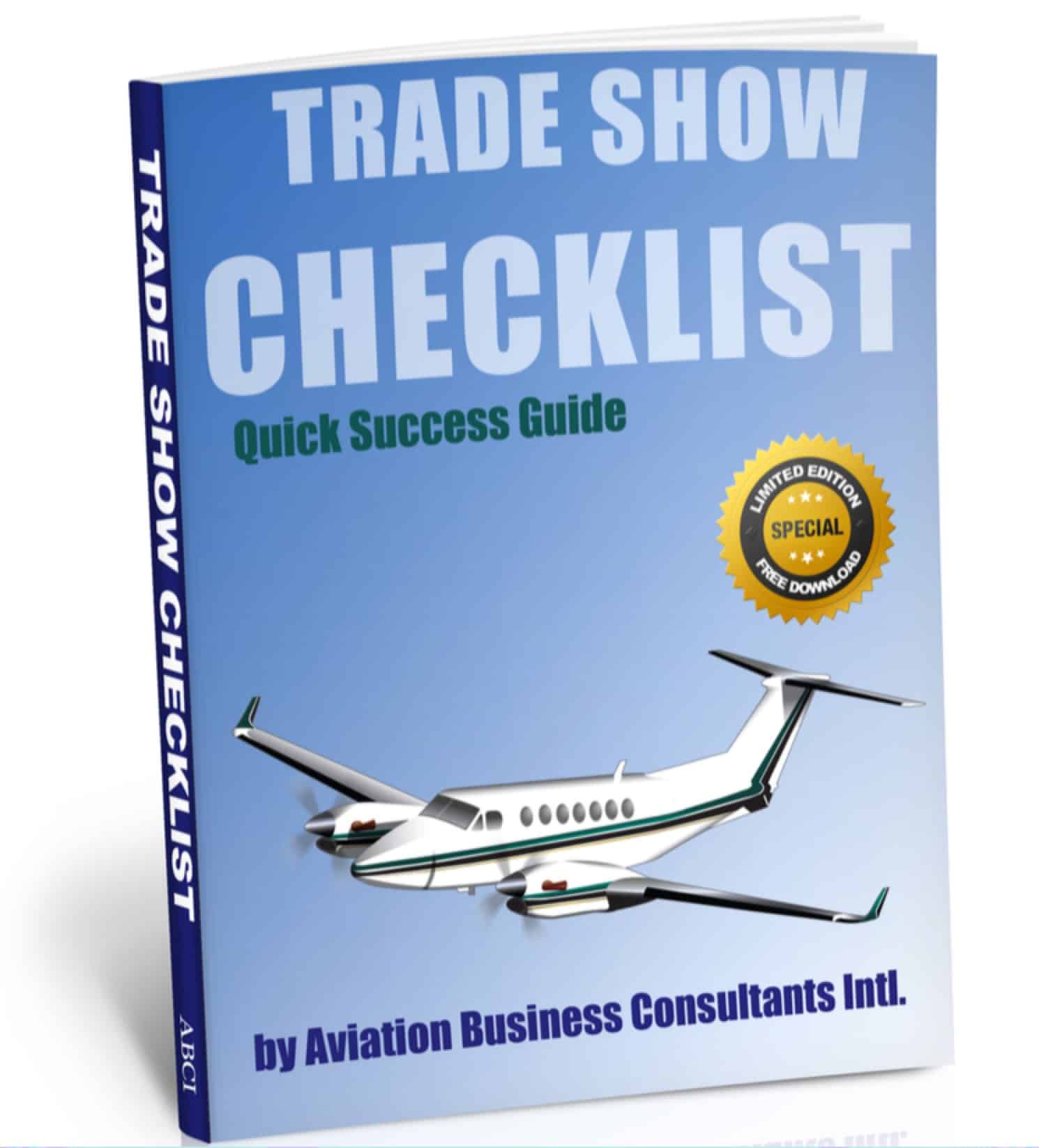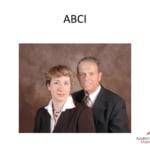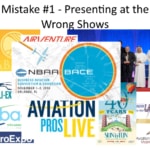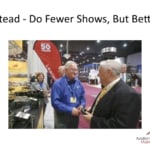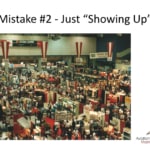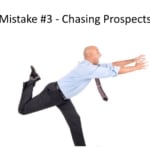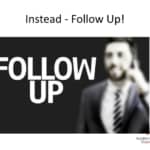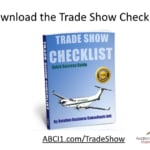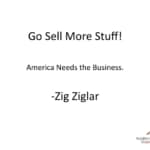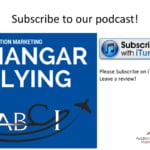Trade shows are a huge, and very powerful part of the marketing plans for MANY aviation companies. Of course, they are also a big investment. We talk about four common trade show mistakes and what to do instead.
![]()
![]()
![]()
Transcript – Aviation Trade Show Disasters & How to Avoid Them
Paula Williams: Welcome to aviation marketing Hangar Flying Episode 33. Trade Show Disasters & How To Avoid Them.
John Williams: Hopefully.
Paula Williams: [LAUGH] I’m Paula Williams.
John Williams: And I am John Williams.
Paula Williams: And we are ABCI. And ABCI’s mission is.
John Williams: To help all you ladies and gents out there sell more stuff in the aviation world.
Paula Williams: Absolutely, so if you’d like to join the conversation, you can use the hashtag #avgeekmarketing. That’s pound, avgeekmarketing and we promise we will reply to every tweet. And also if you have any ideas about guests that you would like to hear. Aviation people who have great ideas and things like that or if you have a great idea about marketing for the aviation industry we’d love to talk with you about being a guest.
John Williams: Yep, that’ll work.
Paula Williams: Okay, so one of the things that we talk about the most is that we never want to see random acts of marketing. We want to make sure that people know what they’re doing, and why. And a really good place to see fabulous exhibits of random acts of marketing is just [CROSSTALK] about any aviation trade show.
[LAUGH] Right?John Williams: The other problem with random acts of marketing, forgetting the fact that it’s not part of an integrated plan, it’s expensive. It doesn’t get you anything.
Paula Williams: Exactly and it is really easy to run up a lot of expense very quickly at a trade show especially, so this is a very high cost investment.
High risk investment for a lot of our clients. We want to make sure everything goes correctly.
John Williams: You do random acts of marketing. If anybody knows what a random generator is, a number generator on a computer, that’s what your customer sales are going to look like.
Paula Williams: [LAUGH] Yep that’s for sure.
So we want to make sure that we’re doing the very best we can and making the very best possible use of your investment of time and money and shoe leather and everything else that you do in a trade show. They’re a lot of money and a lot of work.
So mistake number one I’m going to say is presenting at the wrong shows, right?
John Williams: Or trying to do too many of them.
Paula Williams: Yep, absolutely. So we have presented at the wrong shows before.
John Williams: Yes we have.
Paula Williams: [LAUGH] And it becomes fairly obviously when you’re there if you are having a hard time explaining what you do to the people there and they don’t really seem to understand the need for what you do.
You are in the wrong place and you have spent money to be in the wrong place, which is a really bad place to be but at least you don’t repeat that mistake.
John Williams: Even in the smaller shows then this using this smallest booth, the ten by ten, you guys spent 2,500 to $3,000 just to have a decent presence.
Paula Williams: Exactly.
John Williams: And that doesn’t count travel costs and people costs and everything else.
Paula Williams: Mm-hm. Right, so the thing you really want to do is do your research before the show. Look at the demographics of past shows. Almost all of the show promoters will send you a packet of information.
Or you can find it online where you can see, these are the sorts of people that come and make sure that they hit your target demographic of people that are really going to need your product or service and understand what it is that you sell. So if they’re not your ideal customers don’t bother showing up.
John Williams: And, think through the annual cost of the trade show or trade shows that you go to, because once you start, if you stop, people are going to think you went out of business.
Paula Williams: Right, so you want to pick shows that you are going to go to every single year in the future.
Because if you make it a tradition of being there and then you decide not to show up then you’ll be talked about just as much.
[tweetthis]If you make a tradition of a trade show and then don’t show up, your absence will be talked about![/tweetthis]
John Williams: And not positively.
Paula Williams: Exactly.
John Williams: Positively talked about but not in a positive manner.
Paula Williams: Yeah exactly. So there are lots and lots and lots of shows to choose from and you can go to our aviation service directory.com and look under events and you can see every single month there are lots of shows in the United States, lots of shows in Europe, shows in the Middle East and Asia- Latin America.
John Williams: They’re everywhere.
Paula Williams: Exactly and there are shows-
John Williams: They even have them in South Africa.
Paula Williams: Right, on specialties within aviation. So some of them are focused towards defense, some of them are focused toward general aviation, some of them are focused toward business aviation. And different sizes I’m going to say of-
John Williams: Those.
Paula Williams: Companies. So if you’re looking for, looking to do business with smaller companies then some of the regional shows might be a lot more cost effective for you than going to the big annual shows in some cases.
John Williams: Well last time I put a list together I think there were 265 shows large enough that we would consider going to them annually.
Paula Williams: Exactly, yeah every year our members get a list of shows that they can go through with a highlighter. One of our first meetings of the year we go through the list with a highlighter and say here are the shows that we’re interested in finding out more about.
And we usually for most of our clients, don’t recommend that they do more than about four shows a year because those are the ones that you can do the research for. You can do the preparation, you can pick out your top ten most wanted customers, you can do the work on the front end and the back end to make those really worth the money.
John Williams: And you don’t want to do them back to back because by doing that, unless you’re a larger company, you don’t have the personnel to do the follow up necessarily from each trade show.
Paula Williams: Exactly, now if you were a large company and you’re set up to do trade shows that’s a different scenario but what we recommend for most folks is that they do fewer shows but do them better.
John Williams: Absolutely.
Paula Williams: Right and how you do them better is you plan, and we’ve got a great checklist that does 90 days in advance, 60 days in advance, 30 days in advance. And then of course your followup after the show, and then 30 days after the show. Has all of that lined out for you in our trade show checklist and we’ll talk about that in just a few minutes.
That’s the first mistake and I would say probably the most expensive mistake. [LAUGH] And the most catastrophic mistake, the hardest to recover from is presenting at the wrong shows or presenting at too many shows. So might want to look at your calendar and think about you know where can I cut back here and do it once take the hit, get talked about, but you can always communicate with your customers and say you know what?
We have decided to do fewer shows but do a better job of follow-up after and everything else. And most people will respect that, if you explain your reasons, right?
John Williams: Mm-hm.
Paula Williams: Okay, mistake number two is just showing up.
John Williams: [LAUGH]
Paula Williams: When you are in an environment like this, where you’ve got thousands of people, lots of shiny objects.
You’ve got the big aircraft manufacturers always have fabulous, shiny, beautiful booths with a shiny aircraft on a turn table or something, dancing girls and elephants. I’m only halfway kidding here. Balloons and everything else. If you just show up in a ten by ten booth and have a banner and sit, you are not going to attract much attention because all of your competition is doing a whole lot more to attract the attention of the people wandering the show.
John Williams: Well not only that, you need to plan ahead far enough, because if you plan ahead far enough, an NBAA is a year or more advance. [COUGH] You can pick where you want your booth to be. Having been there enough times and you know where the traffic’s going to be by looking at the map.
And you have a better chance of getting your booth in a place where people can walk by it.
Paula Williams: Mm-hm.
John Williams: Whether they want to or not.
Paula Williams: Absolutely, and that makes a big difference. Your placement might make a investment in a show go from abysmal.
John Williams: [LAUGH]
Paula Williams: To really, really good. So it’s just a matter of where you are on the floor.
John Williams: Yeah sometimes it is.
Paula Williams: Mm-hm. Right and there’s a lot of things that you can do if you do the planning in advance that don’t cost a lot of money. So some of the things that we’ve done successfully are to have a trivia quiz or something like that on your subject of expertise that costs almost nothing.
You can just print up some little blanks. Send invitations to the people that you know saying that you’re having a trivia quiz. You can give away a few prizes. You can do a drawing for each day of the show or even just one drawing in general. Not spend a whole lot of money.
John Williams: But it needs to be your business or your product suite oriented.
Paula Williams: Yeah.
John Williams: We have seen people give away iPads just by merely dropping a business card in a fishbowl, well what the hey? I mean, so you win.
Paula Williams: Mm-hm.
John Williams: The guy doing this is losing his money on the iPad cuz he doesn’t know anything about you.
I go to those things, I always drop my business card in to see if I can win, because I don’t have to do anything else. But that’s not good. What you want them to do is to ask about your product, do something, get your information so they can contact you later, and so forth.
Paula Williams: Exactly so if you have a drawing for a free iPad with no conditions around it or no nothing that they have to do for that, you’re going to get a lot of people who have no interest in your company. And you’re going to have fishbowl full of people, who just walked by and won’t even remember the name of your company, that just entered.
So you really do want to put some onus on the customer to prove that they are actually a valid prospect for your product or service. So some of the ways you can do that are trivia quizzes, we talked about that, other kinds of contests, product demonstrations, sign up for an appointment or a demonstration and we’ll enter you in a drawing.
There’s lots of ways that you can.
John Williams: Or just talk to people.
Paula Williams: Yeah.
John Williams: And ask them if they profess an interest in your product. Really, and how does that apply to your business?
Paula Williams: Absolutely, so think through what are you going to do when people come to your booth, or how are you going to attract people to your booth?
And that checklist really is a good way of giving you some ideas, and ways to plan a good contest or invitation or a demo or something that gets the right people.
John Williams: I have to add here the old tired cliche.
Paula Williams: Uh-huh.
John Williams: But with that slide up there I have to say it.
Paula Williams: Okay.
John Williams: Failing the plan is planning to fail.
Paula Williams: That was Norman Schwarzkopf, right?
John Williams: Yeah, I believe, whatever.
Paula Williams: Okay.
John Williams: But it’s true actually.
Paula Williams: If you’re doing too many shows, frankly, you just don’t have the time, energy, or enthusiasm to plan as well as you really should.
John Williams: You need to be planning minimal 90 days ahead of time and all the way through the show and then 90 days afterward. So your plans gotta incorporate that amount of time.
Paula Williams: Mm-hm. Absolutely, all right, so mistake number three, chasing prospects.
John Williams: Never a good idea.
Paula Williams: Never a good idea.
So there are some shows where there are booths where people actually actively avoid. They walk the long way around to avoid going by specific booths because they have very aggressive sales people. The purpose of a trade show in most cases in the aviation industry is not to actually make a sale.
Most of our products are complex or high dollar products, people don’t make impulse purchases. And they’re not going to make a decision today. So the best that you can hope for is contact information, interest, and permission to follow up later, and hopefully they will remember you because you had something interesting to say.
John Williams: Then explain why Airbus and Bell and those other guys, NBA announced we just sold 300 whatever.
Paula Williams: Yeah airplanes at the show. That didn’t happen at the show, that was in negotiation for six months before the show. They just timed it to coincide with the show so that they could take-
John Williams: For PR-
Paula Williams: The attention of the news media who happens to have their lens focused and have all of these tabloids to fill, the Show Dailies and things like that. So those press releases are full of sales and a lot of people get really excited about that but what you’re seeing in most cases is pre-planned, pre-determined.
The company that’s making the sale gets publicity, the company that made the purchase gets the publicity and they time that to coincide with the show.
John Williams: Yes they do.
Paula Williams: Very few decisions are actually made.
John Williams: You can bet they don’t chase people.
Paula Williams: No. [LAUGH] Exactly. So what you want to do instead is think like speed dating.
If you read any of the advice columns and things like that in Facebook, not that I do that, about speed dating, and we are happily married by the way. But some of our kids have been involved in dating adventures of various sorts and misadventures of various sorts. In these speed dating environments the only thing that you want to do is figure out if you want to see each other again.
And that’s really the only thing that you’re doing at a trade show, is figuring out if you have an interest in seeing each other again. Do we have a product that will help you with a problem? Or do you have a problem that I can help you with?
That is it.
John Williams: And then exchange contact info.
Paula Williams: And exchange contact information. Anything beyond that is asking too much of the venue. And is going to be counter productive right?
John Williams: Yep absolutely. I mean you may get lucky and make a sale. Don’t be afraid to sell if somebody wants to buy right then.
Paula Williams: Yeah. Be prepared.
John Williams: But it’s typically not going to happen.
Paula Williams: Exactly, so you just want to think in terms of the first step. You just want to move the ball five yards down the field, you don’t want to make a touchdown here. It’s just too much pressure for too little time.
All right mistake number four is not chasing prospects.
John Williams: [LAUGH] Wait a minute, you said earlier.
Paula Williams: I know I am contradicting myself. So you are there to make sales, you are there to further your sales objectives. But like we said, five yards at a time. If you don’t make five yards.
If you don’t exchange contact information, [CROSSTALK] if you don’t identify your ideal customer-
John Williams: I don’t think chasing is correct, I think you want to use the word pursue.
Paula Williams: Okay.
John Williams: [LAUGH]
Paula Williams: So mistake number four is not pursuing your prospects. You really should go in armed with a list of people that you want to talk to or companies that you want to talk to so that you can at least narrow down who is the right person to talk to once you get over there.
And you really want to do what you can to advance your sales process with each of the folks that comes to your booth. In a lot of cases the people that man the booths have zero interest in doing anything other than killing time till cocktail hour.
John Williams: Right.
Paula Williams: And you can see that and those are not engaging sales people.
John Williams: And those are the opposite of the aggressive guy that won’t let anybody go by, he’s got to tell you everything.
Paula Williams: Exactly and that’s kind of the difference between having the owner or a very aggressive sales person in the booth versus having hired help basically in the booth that gets paid the same whether they sell anything or not.
So you want to make sure that the people in the booth are engaged, they’re part of the company. It’s usually best if they know something about the product or service. They’re not just hired guns. Or if they are hired guns, they have some knowledge. You’ve given them enough AQ, you’ve given them a quiz ahead of time so you know that they know their stuff.
You give them some incentive for collecting contact information of legitimate prospects. So you need to strike a balance there of chasing versus not chasing, right?
John Williams: Absolutely.
Paula Williams: Okay, and the main thing here is follow up. All of the sales happen after the show. And they may happen the week after.
They may happen six weeks after. They may happen six months after. We don’t know. It really depends on your product and it depends on your customers.
John Williams: You need to follow up because that list of leads that you have is very perishable.
Paula Williams: Right, what does that say?
The only difference between a salad and garbage is?
John Williams: Time. [LAUGH]
Paula Williams: Time, exactly. And the only difference between a list of really good leads and a list of really bad leads is?
John Williams: Time.
Paula Williams: Time, exactly. They’ll do something else. They’ll forget that they had a conversation with you.
Lots of things are going to happen if you don’t get back to them. So what we like to do is see something happen the week that you get back from a trade show and that’s could be a hand written card, it could be a post card, it could a phone call.
Something needs to happen immediately so that they remember you, kind of anchor that in their memory. And then you have a follow-up program that lasts however long your sales cycle is predicted to last. In most cases in the aviation industry, we plan on usually about eight months, right?
John Williams: Yes.
Paula Williams: Yeah.
John Williams: Except for the really small items.
Paula Williams: Yep, that’s true. There’s a lot of people to be consulted, a lot of policy, a lot of budget stuff that goes into those purchases. All right, so actions. Present at fewer shows, but do them better.
John Williams: Absolutely.
Paula Williams: Don’t just show up, have a plan. Don’t aggressively pursue the sale. All you want them to do is get them to want to talk to you further. Get permission to follow up with them. And the last thing of course is, don’t fail to follow up. That happens so often.
I mean of all of the cards that I’ve dropped at trade shows, I would say less than 10% actually follow up with me. Have you seen that? Or what’s your-
John Williams: Absolutely, and the fact is that if they get one of my cards and they don’t follow up, they’re lost.
I don’t just hand my cards out to anybody.
Paula Williams: Right, exactly and you’re much more conservative than I am, being in marketing I throw them everywhere like confetti. Because I want to see how people do their marketing, it’s research right. I end up buying a lot of products but I do spread a lot of cards in places like this because I do want to see what their sales process is like.
And 10% is probably over stating the case. But very few companies actually follow up. So the ones that do have huge advantage. So you want to make sure that you do that. Okay, so here is the Trade Show Checklist I was talking about. Just go to ABCI1.com/Tradeshow. This is actually a checklist that we’ve been using for quite some time.
We update it every year. And you may already have a copy, which is great. If you do, dust it off and use it. If you don’t have it, get it. That’s Alpha Bravo Charlie India number 1.com/Tradeshow. Now go sell more stuff. America needs the business.
John Williams: That’s Zig Ziglar.
Paula Williams: Zig Ziglar, subscribe to our podcast. We are on iTunes, Google Play and Stitcher so please do subscribe and please do leave us a review. And once again if you do know somebody who would be a great guest on our podcast, we’d love to hear from more voices other than just John and me.
So if you know somebody who has a really great idea about marketing in the aviation industry or if you have some thoughts that you want to share. We’d love to have you on as a guest on the show and we promise to be mostly nice, right?
John Williams: No.
Paula Williams: No, [LAUGH] have a great week and we’ll talk to you later.
Download our Trade Show Checklist here:
Need more help? Get our consultants to do the work with you with our Trade Show Program
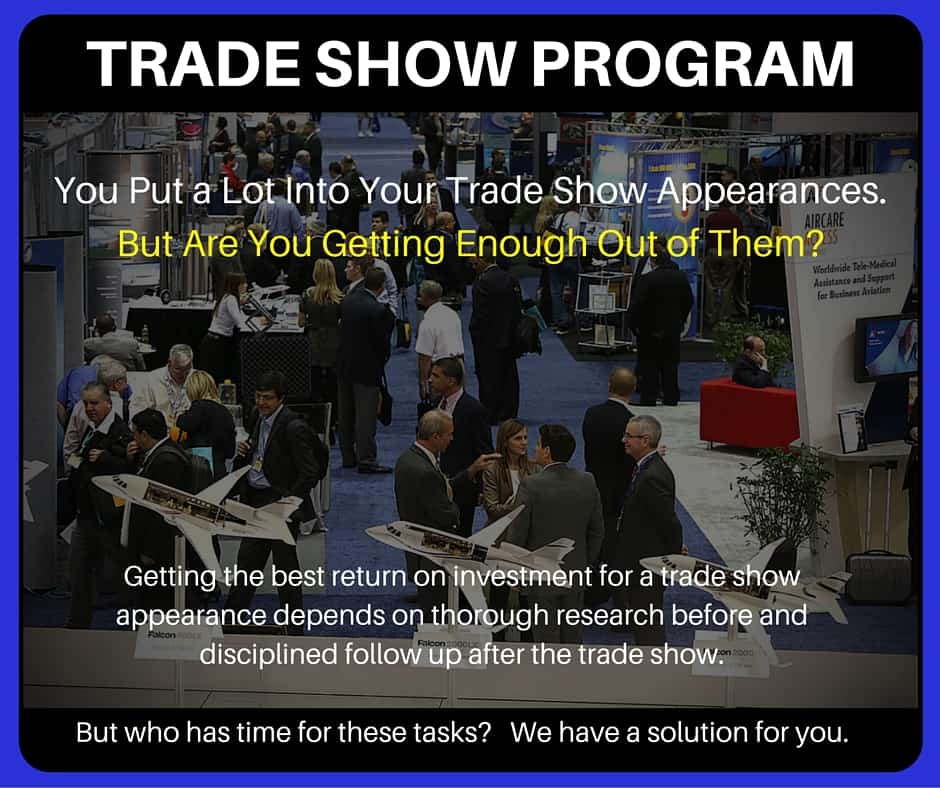
AMHF 0036 – Aviation Marketing Trade Show Secrets –
The biggest aviation trade show marketing secrets are not really secrets. In fact, it’s those very things that you think should be SO OBVIOUS but NOBODY SEEMS TO DO THEM. In decades of attending aviation trade shows as a buyer, seller, and consultant, we see that maybe ten percent of companies actually do what they say they know they should do.
Aviation Trade Show Disasters and How to Avoid Them
Trade shows are a huge, and very powerful part of the marketing plans for MANY aviation companies. Of course, they are also a big investment. We talk about four common trade show mistakes and what to do instead.
Aviation Trade Shows – A Book Club Discussion – Trade shows by Steve Miller
Book club conversation – How to Get the Most out of Trade Shows by Steve Miller
Rich people have big libraries. Poor people have big TVs.
Jim Rohn
We discuss one popular book each month, from the perspective of the aviation industry!

